I have a pair of Tannoy System 800 monitors that I got many years ago in a closing down sale. The sound of them has always puzzled me. The specs look great on paper, but they just don't sound right. They are OK as nearfield monitors (apart from the size!) but when used in an ordinary room as hi-fi speakers they sound very dull and lacking in high end, and the midrange seems recessed and muddled too.
I'm guessing this might have something to do with dispersion. I noticed that Tannoy fitted a dome tweeter to help out the coax driver in later models. Does anyone have any thoughts on the matter?
I'm guessing this might have something to do with dispersion. I noticed that Tannoy fitted a dome tweeter to help out the coax driver in later models. Does anyone have any thoughts on the matter?
The matter... Have you read about the difficulty of having an 8" woofer and a tweeter ? there are some threads about it; indeed, I see that modern Tannoy production utilizes waveguides for the tweeters= equals the dispersion at crossover frequency. Utilizing the cone of the woofer itself as a WG has some pros and cons, but I would blame the compression driver for the lack of highs-treble&supertreble. The only 8" I use ( a 50W Vifa ), I use it together with a modern cheap 2" in a 8" waveguide ( made from dead speakers ). Same for a 10". I wouldn't let them play more than mid-bass duties.
Then there's the cabinet and the crossover, and they play important (...vital ?!?!? ) roles.
Then there's the cabinet and the crossover, and they play important (...vital ?!?!? ) roles.
If the speaker is voiced for near fielding, as is the case with System 800, it will inevitably lack HF when used for far fielding. Since the driver in your Tannoy is excellent, you should figure out how to rise the level of the tweeter by changing the values of resistors in the crossover that define the level of tweeter. There is probably crossover schematic supplied with the speaker?
I got reasonable results using a DEQ2496 ahead of the power amp to boost the HF, but I was wondering what is the theoretical basis for needing to do this, and whether the driver was considered to be any good in the first place.
I'm pretty sure the HF drivers are working. They sounded like this since the day I got them, nothing has changed. Other Tannoy coaxials I've heard sounded similar.
If all crossover elements are functional and HF driver is undamaged, all you could do is use tone controls on preamp, change the resistors in the crossover (unless HF level is defined by autoformer) or use DEQ.
There is no doubt that driver itself is excellent: high efficiency, unsurpassed time alignment, reasonably flat response achieved with minimalistic crossover, etc. That loudspeaker is a keeper!
There is no doubt that driver itself is excellent: high efficiency, unsurpassed time alignment, reasonably flat response achieved with minimalistic crossover, etc. That loudspeaker is a keeper!
The "super tweeter" was and is a horrible idea.
Perhaps yours were simply miswired from the factory. Have you measured them?
Perhaps yours were simply miswired from the factory. Have you measured them?
I did some in-room measurements recently while trying to figure out the problem, that showed a mysterious notch in the SPL at about 1.5kHz. Now you mention it, a HF driver wired backwards could well explain that.
Last edited:
I'd say : space alignment, as time is a matter of how the mechanic respondsThere is no doubt that driver itself is excellent: high efficiency, unsurpassed time alignment...
to the electric signal, which itself is under influence of the passive elements in the crossover ( phase)
😱
😕
I tried another rough measurement using a mic directly in front of the cone, hooked up to the RTA on my Behringer DEQ. I saw an obvious notch at 1500Hz. According to the manual, the crossover frequency is 1800Hz.
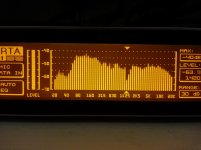
I reversed the wires to the tweeter and repeated the measurement. The notch disappeared and on listening to music, the midrange output seemed a lot better.
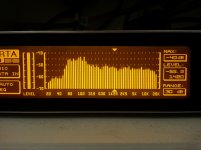
Could Tannoy really have wired up the tweeter backwards? 🙁 The spade terminals are different sizes and can't be mixed up. But a deep notch at the crossover frequency is exactly what you would expect from a well designed crossover that happened to have one of the drivers hooked up backwards.

I reversed the wires to the tweeter and repeated the measurement. The notch disappeared and on listening to music, the midrange output seemed a lot better.

Could Tannoy really have wired up the tweeter backwards? 🙁 The spade terminals are different sizes and can't be mixed up. But a deep notch at the crossover frequency is exactly what you would expect from a well designed crossover that happened to have one of the drivers hooked up backwards.
It is possible that they messed something up, but I would be cautious about coming to any conclusions with the microphone placed close to the driver. In this case, for proper driver and xover summation, you really need to have the mic at a distance of roughly twice the diameter of the cone of the mid/bass.
I wouldn't normally stick a mic so close, but the Tannoy is a coaxial design with the tweeter firing through the middle of the woofer pole piece, and is supposed to be time aligned, so I figured the phase should be the same everywhere.
Besides, I previously saw the same notch in an in-room measurement from 12ft away.
Besides, I previously saw the same notch in an in-room measurement from 12ft away.
It's not just about summation between two non coincident sources, it's about how the sound itself radiates from the cone and how the sound radiates from the throat of the tweeters wave-guide and then how its dispersion is affected by being loaded by the geometry of the cone.
When performing nearfield (and by this I mean with the mic in very close proximity to the cone) measurements, you can get cancellation effects occurring that have nothing to do with crossovers and everything to do with cancellation effects caused by the geometry of the cone itself relative to the mic position.
I am not saying that you aren't right, and it would appear that the xover might be connected up incorrectly, but if the mic really is extremely close, you would be far better off performing an impulse response measurement, with something like ARTA, at around 50cm, and gating the response to see exactly what is going on.
When performing nearfield (and by this I mean with the mic in very close proximity to the cone) measurements, you can get cancellation effects occurring that have nothing to do with crossovers and everything to do with cancellation effects caused by the geometry of the cone itself relative to the mic position.
I am not saying that you aren't right, and it would appear that the xover might be connected up incorrectly, but if the mic really is extremely close, you would be far better off performing an impulse response measurement, with something like ARTA, at around 50cm, and gating the response to see exactly what is going on.
It does not have to be incorrect wiring at the factory. Sometimes tweeter connectors are marked incorrectly on the production line. It happened frequently with Eminence APT 50 and Adire kits using them, as noted by Joe D'Appolito in a AudioXpress reviw of one of those kits.
There's easier way to find if drivers are out of phase. Play sinus from function generator and slowly go from 1kHz to over 2kHz sitting in your listening position. If drivers are out of phase you should clearly hear attenuation at crossover frequency, from one or both loudspeakers (depending on which one is out of phase).
I tried this experiment again according to the suggestions I got above. This time I supported the speaker in midair close to the centre of the room, placed the mic 50cm away on axis, and did some impulse response measurements with ARTA. I haven't done this before, so I hope I set up the gating correctly.
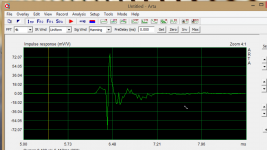
The impulse response with the tweeter in the factory config.
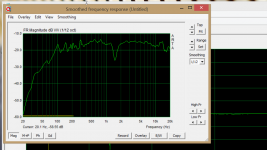
The dual gated frequency response calculated from it. The notch at 1500Hz is clearly visible.
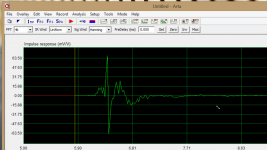
The impulse response with the tweeter reversed. Doesn't really look any better... 😕
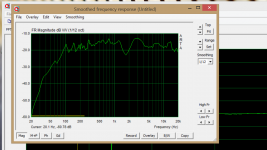
According to the frequency response measurement, the dip hasn't gone, it just moved a bit higher in frequency and got broader and shallower.
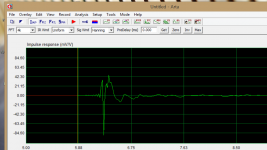
As a sanity check I substituted the Tannoy speaker for a known good Dynaudio BM5.
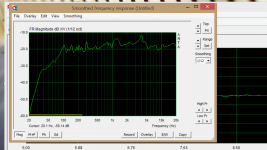
The calculated frequency response of the BM5. No sign of the dip.

The impulse response with the tweeter in the factory config.

The dual gated frequency response calculated from it. The notch at 1500Hz is clearly visible.

The impulse response with the tweeter reversed. Doesn't really look any better... 😕

According to the frequency response measurement, the dip hasn't gone, it just moved a bit higher in frequency and got broader and shallower.

As a sanity check I substituted the Tannoy speaker for a known good Dynaudio BM5.

The calculated frequency response of the BM5. No sign of the dip.
Clearly the design could do with a crossover redesign as something funky is going on there that shouldn't be. I mean this could be related to the unique dual concentric tweeter, but without making individual measurements of the drivers, with the crossovers removed, you won't know.
Interpreting the impulse responses - the first one appears to have the woofers impulse arriving first with the driver connected with positive polarity. Then comes in the tweeters response, indicated by the very quick and sharp impulse. It is connected with reversed polarity as is indicated by the negative going initial peak. After the tweeters response is over you then see the slow negative portion of the woofers longer decay coming in.
In the second impulse response you're basically seeing the same, except that the tweeters peak/dip is now reversed.
Which one is right depends entirely on what order of crossover is used. A second order network has the tweeter connected with a nominally reversed polarity, but because of the phase shift present throughout the crossover region, the drivers sum properly in phase.
There is nothing abnormal looking about either impulse response and it's what you'd actually expect given that the tweeter itself is situated somewhat behind the acoustic centre of the woofer, at the end of its wave guide.
It is possible that the crossover could contain some non polar electrolytics that have degraded over a time and are now out of spec. This could easily result in abnormal behaviour. Tannoy's own measurements for the 800 in the instruction manual show no dips anywhere.
Edit - I thought I would also point out that the Tannoy's do obviously extend out to 20kHz, so the fact you don't find them particularly bright could simply be due to the different dispersion pattern that the Tannoy's will have. Most standard cone/1" dome tweeter designs have a wide - narrow - wide type of dispersion pattern, with a standard beaming type dispersion at the top of the tweeters response. The Tannoy's wont display this and as such will be more wide - narrowing a little - controlled constant directivity. This will give you a different kind of presentation and is usually one that is preferred. Not everyone will prefer it mind you, but it's just to let you know that there is a real reason why they could sound different in the top end and are far more likely to sound laid back throughout the mid range too.
Interpreting the impulse responses - the first one appears to have the woofers impulse arriving first with the driver connected with positive polarity. Then comes in the tweeters response, indicated by the very quick and sharp impulse. It is connected with reversed polarity as is indicated by the negative going initial peak. After the tweeters response is over you then see the slow negative portion of the woofers longer decay coming in.
In the second impulse response you're basically seeing the same, except that the tweeters peak/dip is now reversed.
Which one is right depends entirely on what order of crossover is used. A second order network has the tweeter connected with a nominally reversed polarity, but because of the phase shift present throughout the crossover region, the drivers sum properly in phase.
There is nothing abnormal looking about either impulse response and it's what you'd actually expect given that the tweeter itself is situated somewhat behind the acoustic centre of the woofer, at the end of its wave guide.
It is possible that the crossover could contain some non polar electrolytics that have degraded over a time and are now out of spec. This could easily result in abnormal behaviour. Tannoy's own measurements for the 800 in the instruction manual show no dips anywhere.
Edit - I thought I would also point out that the Tannoy's do obviously extend out to 20kHz, so the fact you don't find them particularly bright could simply be due to the different dispersion pattern that the Tannoy's will have. Most standard cone/1" dome tweeter designs have a wide - narrow - wide type of dispersion pattern, with a standard beaming type dispersion at the top of the tweeters response. The Tannoy's wont display this and as such will be more wide - narrowing a little - controlled constant directivity. This will give you a different kind of presentation and is usually one that is preferred. Not everyone will prefer it mind you, but it's just to let you know that there is a real reason why they could sound different in the top end and are far more likely to sound laid back throughout the mid range too.
Last edited:
Yup right now I am suspecting some sort of crossover SNAFU at the factory. The frequency response graph in the manual shows a ~2dB dip at the frequency where I have the 12dB dip. They probably used a lot of smoothing, but the dip I see covers a whole 1/3 octave, so I don't see how they could have hidden it.
The explanation of different dispersion patterns certainly makes sense, especially since I've been using them as hifi speakers in a somewhat reverberant room. I thought the narrower dispersion might even be helpful in terms of firing more direct sound at the couch. But I found that even after adding a bit of HF boost to compensate it, they still sounded somewhat off.
This seems reasonable. To my understanding the dual concentric driver is not actually time aligned as many people claim.There is nothing abnormal looking about either impulse response and it's what you'd actually expect given that the tweeter itself is situated somewhat behind the acoustic centre of the woofer, at the end of its wave guide.
The explanation of different dispersion patterns certainly makes sense, especially since I've been using them as hifi speakers in a somewhat reverberant room. I thought the narrower dispersion might even be helpful in terms of firing more direct sound at the couch. But I found that even after adding a bit of HF boost to compensate it, they still sounded somewhat off.
Last edited:
If the crossover is lacking then that could well account for why they sound off. Wave guide, or more controlled directivity designs, tend to be far more forgiving of the environment they are placed in. I wouldn't say they sound dull, but they don't tend to sound 'bright' or rather, they don't tend to sound airy, just very well controlled in the higher frequencies.
- Home
- Loudspeakers
- Multi-Way
- Tannoy System 800 never sounded right